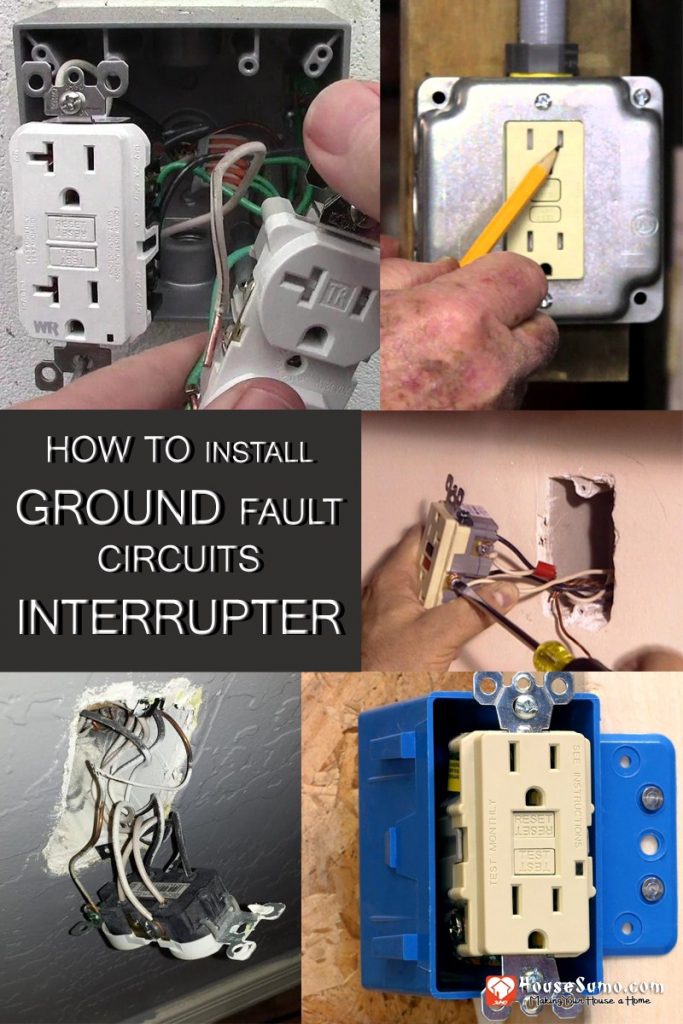DIY installation of GFCI Receptacles. How to install ground fault circuit interrupter in ungrounded houses.
This article covers the installation and wiring of GFCI receptacles for additional protection when a ground wire is not present but includes connecting the ground wire for those with a grounded wiring.

Ground Fault Circuit Interrupter receptacles provide additional safety, especially if your house wiring does not include ground wires. To find out how easy these receptacles install, read about how to install ground fault circuit interrupter in ungrounded houses below.
Must Read:
Grounding devices that operate on electricity are important. If the electrical current from a broken or detached wire touches a conductive case or cover, the ground wire diverts the current safely to the ground and may cause the circuit breaker to trip or a fuse to blow. This prevents electrical shocks and fires.
The National Electric Code now requires GFCI receptacles near sinks, in kitchens, bathrooms, basements and outdoor circuits.
A GFCI can shut off the current if a short occurs between a circuit wire and ground, without a ground wire necessarily being present. The interruption happens so quickly it prevents electrocution. The ideal situation is one where a GFCI and a ground wire are both present.
But a GFCI can add considerable protection in older homes without ground wiring. This is how to install ground fault circuits in ungrounded houses.
Purchase Ground Fault Circuit Interrupter receptacles with a current rating that matches the current rating of the circuit they will be used on. A 20-amp circuit needs a 20-amp GFCI receptacle.
Important:
Turn off the circuit breaker or remove the fuse that supplies the circuit you will be working on. Never work on a live circuit. Test the receptacle you are replacing with a neon voltage tester by inserting the leads into the outlet slots. The lamp stays off if the circuit is turned off.
Remove the receptacle cover plate screw and cover plate, then remove the two screws that hold the receptacle in place and gently pull the receptacle out of the wiring box. It should be attached with one white wire and one black or other colored wire. Loosen the terminal screws and remove the wires from the receptacle. If your home has a bare ground wire attached to a green screw, remove that wire from the screw as well.
The GFCI receptacle has two sets of terminal screws. One for incoming wires that come from the service panel and another set that can connect to a downstream device and extend protection to that device as well. One set is labeled “LINE”, the other set is labeled “LOAD”. Look for the terminal labels on the back of the receptacle.
If your wiring includes a ground wire, attach the ground wire first to the green terminal screw.
Place the end of the white wire on the silver “LINE” terminal screw. This screw connects to the wider slot on the front of the receptacle. Tighten the terminal screw firmly.
Place the end of the black or colored wire on the brass “LINE” terminal screw. This screw connects to the narrower slot on the front of the receptacle.
If you wish to connect another outlet to this receptacle, connect those wires to the “LOAD” terminals. Connect the white wire to the silver terminal first, then connect the black wire to the brass terminal.
Carefully fold the wires behind the receptacle as you push the new GFCI receptacle into the wiring box. Attach the receptacle with the provided screws and install the cover.
Turn on power to the receptacle. Insert the leads of a neon voltage tester into the two receptacle slots. The neon light should glow. Press the “TEST” button and repeat the test with the neon voltage tester. The neon lamp should remain off. Press the “RESET” button and the new receptacle is ready for use.
A GFCI continuously measures the current flow between the two wires. If the current becomes unbalanced the internal circuit breaker trips. If the hot wire is becomes shorted to ground, the GFCI sees a high current on the hot wire and a low current on the neutral and stops the flow of electricity.
And if both wires have the same current flow the GFCI will not trip. This means that if you held a metal nail in each hand and stuck them into the receptacle slots, you’d get a nasty jolt at best and at worst could die. The GFCI would not trip because the current in both wires is the same.
GFCI devices provide a superior measure of safety, but won’t protect against shock in all cases. Now you know how to install ground fault circuit interrupter in ungrounded houses.